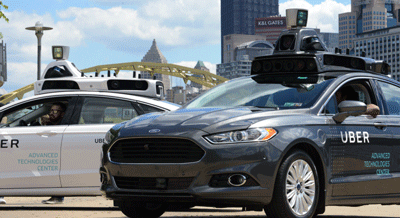Last week, a self-driving car owned by Uber killed a pedestrian in Tempe, Arizona. The Center’s director explains why this tragedy is only a temporary setback for driverless cars.
______________________________
By Jeffrey Cole
In a previous column, I talked about how driverless cars will be the most important development over the next thirty years. Despite my vision for how driverless cars will change the world, it was obvious the road to complete autonomy would be a long one with many bumps.
 On March 18, driverless cars hit a major crisis when a pedestrian was killed in Arizona by one of Uber’s driverless cars. Uber has been testing fully autonomous (Level 5) driverless cars in Pittsburgh and Phoenix for the past year. This accident occurred outside Phoenix in Tempe.
On March 18, driverless cars hit a major crisis when a pedestrian was killed in Arizona by one of Uber’s driverless cars. Uber has been testing fully autonomous (Level 5) driverless cars in Pittsburgh and Phoenix for the past year. This accident occurred outside Phoenix in Tempe.
Uber immediately and appropriately suspended its driverless car program. It’s essential that the program does not resume until there is a full investigation and the cause for the accident is discovered.
Not surprisingly, many critics — who felt Uber started testing too soon — quickly made the case that driverless cars will never work: if they are to be tested, then it should be a much slower process and in places where they cannot harm people .
_________________________________________________________________________________________________
With air travel, we learned in a powerful way, that despite early accidents, “Man is meant to fly.” The Uber accident must be studied, and the problems must be fixed, because our children and their children will learn that “Cars are meant to be driverless.” Our descendants will be amazed and shocked that we allowed human beings behind the wheel of a deadly weapon any longer than absolutely necessary.
_________________________________________________________________________________________________
What happened in Arizona is a tragedy that absolutely needs to be fully investigated. The public must be reassured that they are completely safe as passengers in driverless cars, as drivers, as passengers in other cars, and as pedestrians.
Beyond the lessons that we will learn from the Tempe accident, there are some immediate things we should consider about driverless cars and this incident:
1. Think of this as 1906 in the world of driverless cars. In 1903, the Wright Brothers flew the first airplane at Kitty Hawk, North Carolina, for 59 seconds and a distance of 852 feet. Imagine if, three years later, an aircraft designer tested his plane and crashed, killing himself and someone on the ground. Many critics would have quickly come forward and argued, “see, man isn’t meant to fly.” In the early years of flight, airplanes were not certified for safety, and the only people who would fly them were the designers and their pilots who frequently put their lives at risk.
Since then, air transportation — which changed the world, made it smaller, and increased global commerce — has become statistically the safest form of transportation. We rely on air travel in thousands of ways. None of that would have been possible if, after the first crash, we agreed man was not meant to fly and abandoned the dream of aviation.
2. Uber’s program is an experiment. Perhaps the experiment could have been better designed (we will see as the accident is studied and conclusions are reached). The promise of driverless cars is that 34,000 deaths a year and climbing (because of texting) in the United States can be reduced to single or double digits per year. It is impossible to reach that goal without testing on the roads with other drivers.
Tests on closed courses will yield some important data, but they cannot substitute for actual road testing. If we are to get to the goal of almost no accidents or deaths on the road, testing in real-life situations sharing the road with human drivers is essential. From this accident we have to learn how to improve the testing.
3. The Uber system is one of several driverless systems. There are other competing systems. Tesla started its Level 3 driverless system with Mobile Eye (an Israeli company recently bought by Intel for $15 billion). Thinking they could improve on the Mobil Eye System, Tesla moved to design its own system.
Waymo, another system, owned by Alphabet that owns Google, argued that the Uber accident might not have occurred with their system. Is this competitive boasting and kicking a rival when he is down, or is Waymo correct?
Perhaps the Uber system is flawed, and the company will move to other better systems. In technology we have seen Thomas Edison’s Direct Current compete with Nicola Tesla’s (the great inventor the Tesla car is named after) Alternating Current. Out of their rivalry, we learned that AC was the better technology for lighting homes. A number of people were electrocuted before we found a standard. There are many more example of systems or standards competing before we find the best.
4. Although the death in Tempe was a tragedy, 93 people a day die in automobile accidents in America. On that same day, a number of pedestrians were killed by cars with drivers. None of this minimizes the death from the driverless car. It can be argued, non-scientifically, that already the driverless car tests are saving lives because they are equipped with radar and collision avoidance and can react far faster than humans. Driverless cars may have already saved more lives than they have caused to be lost: one.
5. It may have been the Tempe pedestrian’s fault. As more evidence is coming forth, it is looking more and more that the pedestrian may have jumped in front of the car in a way that even a human-driven car could not have prevented . Despite what Waymo says about its system, perhaps the accident was unavoidable, and any vehicle, driver or not, may have hit her.
_________________________________________________________________________________________________
The promise of driverless cars is that 34,000 deaths a year and climbing (because of texting) in the United States can be reduced to single or double digits per year. It is impossible to reach that goal without testing on the roads with other drivers.
_________________________________________________________________________________________________
As I said above, driverless cars can result in 34,000 deaths a year being reduced to single or double digits. Driverless cars have much more ability to react immediately and save lives than do cars with humans behind the wheel. There will always be people darting in front of cars when it is impossible — no matter who or what drives the car — to avoid hitting the person.
The potential of driverless cars is enormous. They not only eliminate most accidents, they also almost completely reduce traffic, give mobility to the blind, end the awkward conversation with parents or grandparents taking the car keys away, and save many billions of dollars for commuters.
With air travel, we learned in a powerful way, that despite early accidents, “Man is meant to fly.” The Uber accident must be studied, and the problems must be fixed, because our children and their children will learn that “Cars are meant to be driverless.” Our descendants will be amazed and shocked that we allowed human beings behind the wheel of a deadly weapon any longer than absolutely necessary.
____________

Jeffrey Cole is the founder and director of The Center for the Digital Future at USC Annenberg.
See all columns from the Center.
March 28, 2018

